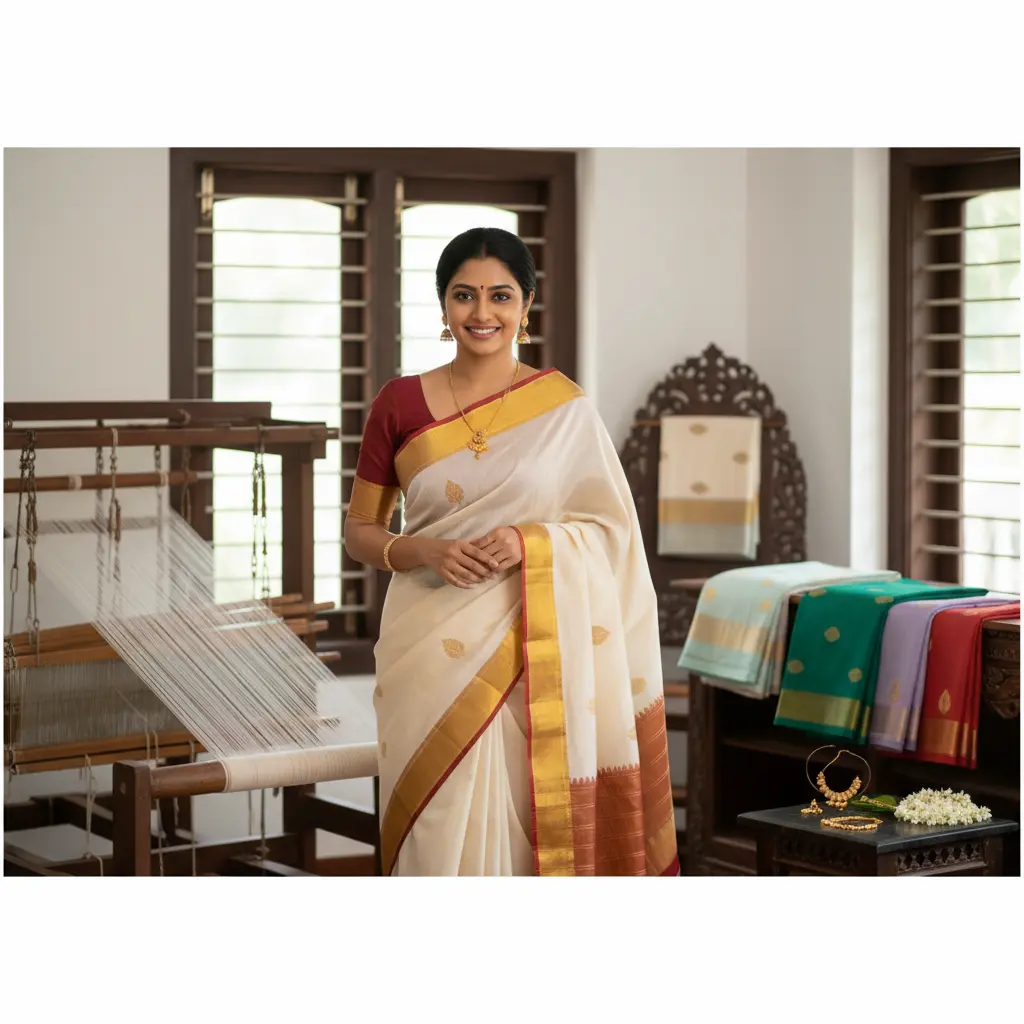Sarees are more than just clothing in India. They are an expression of culture, identity and tradition. Every region of India has a unique weaving style or pattern that tells a story of its people. Among these diverse saree traditions, Haradhi Sarees hold a special place for their graceful simplicity and timeless appeal.
These sarees are gentle, elegant and soothing to the eyes. They carry the warmth of handloom weaving and the softness of cotton, making them ideal for both traditional and everyday wear. If you’re new to Haradhi Sarees and want to understand what makes them special, then this guide will take you through their history, weaving method, styling tips and care instructions in a simple and clear way.
What Exactly Are Haradhi Sarees?
Haradhi Sarees are traditional cotton sarees rooted in Kerala’s handloom heritage. They are known for their light texture, breathable weave and subtle color tones. Most Haradhi Sarees are crafted in natural shades like cream, off-white, beige, or pale ivory, often paired with elegant borders in gold, maroon, green, or black.
Unlike heavily embellished bridal sarees, Haradhi Sarees represent beauty with simplicity. They offer comfort without compromising on style. This makes them suitable for women across generations—from students to brides and from working professionals to elder women in the family.
Furthermore, the saree’s soft fabric ensures that even first-time drapers find it easy to handle, fold and carry throughout the day.
The Defining Features: What Makes Haradhi Sarees Unique?
1. Light and Breathable Fabric
Haradhi Sarees are made from fine cotton yarns that feel gentle on the skin. This makes them perfect for India’s warm climate.
2. Elegant Borders
The borders are woven, not printed, adding depth and authenticity to the saree. They are usually minimal, creating a refined and dignified look.
3. Handloom Craftsmanship
Many Haradhi Sarees are handwoven, which adds character and softness. Every saree carries the touch of the artisan who crafted it.
4. Versatile Style
They can be styled traditionally or paired with modern blouses and jewellery for a contemporary appearance.
A Dive into the History and Cultural Significance
Haradhi Sarees echo Kerala’s long-standing weaving culture. For decades, they have been worn during festivals like Vishu and Onam, as well as temple gatherings and family ceremonies.
The weaving of Haradhi Sarees is passed down from one generation of artisans to the next. Each saree reflects hours of patience, technique and tradition. Wearing one not only connects the wearer to heritage but also supports a living craft.
The Weaving Process: How Haradhi Sarees Are Made
Understanding how Haradhi Sarees are woven gives a deeper appreciation of their value.
1. Yarn Preparation
The cotton fibers are cleaned, combed and spun into soft threads. This ensures the saree remains breathable and smooth.
2. Dyeing and Color Treatment
If the saree has colored borders, the yarn is dyed using natural or AZO-free dyes. Traditional colors include gold, maroon, black and green.
3. Setting Up the Loom
The loom used is typically a pit loom or frame loom. The setup requires precision so that the saree has the right width and border placement.
4. Hand Weaving
The artisan weaves thread by thread. One saree can take anywhere from 2 to 5 days, depending on the border details.
This slow and thoughtful process is what gives Haradhi Sarees their soft, flowing drape.
Furthermore, each weaver adds their personal weaving rhythm, making each saree one-of-a-kind.

How to Style Haradhi Sarees for Different Occasions
Haradhi Sarees are highly versatile. With the right blouse, drape and accessories, they can fit various events and moods.
1. For Festivals (Like Onam, Diwali, Pongal)
- Choose a gold or brocade blouse.
- Pair with temple jewellery (jhumkas, choker, bangles).
- Tie hair in a bun decorated with jasmine flowers.
- Opt for the traditional Kerala drape for a graceful look.
2. For Office Wear or Cultural Days
- Pair the saree with plain cotton or handloom blouses.
- Choose small, simple earrings.
- Wear comfortable sandals for all-day ease.
- Keep the pallu pinned neatly to maintain a professional appearance.
3. For Casual Family Gatherings
- Try printed or embroidered blouses for a fresh style.
- Oxidised jewellery works well for a relaxed look.
- Experiment with open pallu draping for effortless elegance.
4. For Weddings and Receptions
- Select Haradhi Sarees with wider zari borders.
- Match with bold bridal jewellery like long harams.
- Add a waist belt (vaddanam or kamarbandh) for a regal touch.
Moreover, the saree’s subtle colour palette makes it easy to adapt across seasons and fashion trends.
The Modern Haradhi: Contemporary Variations
While traditional Haradhi Sarees are cream-based with simple borders, today’s designers are reimagining them in:
- Pastel tones like blush pink, lavender, mint and powder blue.
- Bold jewel shades like emerald, ruby and sapphire.
- Textured weaves mixed with linen or silk-cotton blends.
- Stylish designer borders incorporating threadwork or geometric patterns.
These modern adaptations help younger generations embrace Haradhi Sarees without losing the original cultural essence.
Sustainability and Ethical Importance
Choosing Haradhi Sarees also contributes to sustainable fashion.
Environmental Benefits
- Handloom weaving consumes far less energy than machine production.
- Natural dyes reduce chemical waste.
- Cotton fabric is biodegradable and skin-friendly.
Support for Artisan Livelihoods
When you buy Haradhi Sarees from authentic weavers or handloom cooperatives, you:
- Support local weaving families.
- Help preserve heritage textiles.
- Contribute to fair wage livelihoods.
In addition, promoting handloom empowers rural craftsmanship and keeps India’s textile identity alive for future generations.
ALSO Read: Pure Handloom Khadi Cotton Sarees
How to Care for Your Haradhi Saree
- Hand wash in cold water with mild soap.
- Dry in shade to preserve color and fabric strength.
- Iron gently while slightly damp.
- Store in cotton cloth bags, not plastic covers.
Frequently Asked Questions (FAQs)
Can beginners wear Haradhi Sarees easily?
Yes. They drape smoothly and are light to carry, making them beginner-friendly.
Are Haradhi Sarees suitable for summer?
Absolutely. The breathable cotton makes them perfect for hot climates.
Do Haradhi Sarees work for weddings?
Yes. With elegant styling, Haradhi Sarees look graceful at weddings and festive events.
How can I verify authenticity?
Look for handloom irregularities, fabric softness and seller credibility.
Where can I buy them?
Purchase from government handloom outlets, trusted online stores, or direct artisan sellers.
Conclusion
Haradhi Sarees are a symbol of purity, simplicity and natural beauty. They blend cultural grace with everyday comfort. Whether you are new to sarees or adding to your traditional collection, Haradhi Sarees offer an elegant choice that celebrates both heritage and modern styling.
Thank you for reading! If you found this article helpful, please share it within your community or groups, leave a comment with your feedback and don’t forget to visit Abmantra for more informative blogs on Women fashion and beyond.

This article has been written by the AB Mantra Team, a group of passionate writers and researchers covering topics across fashion, travel, finance, health, education, technology, lifestyle and business. Our goal is to share accurate, easy-to-understand, and helpful information that adds real value to readers. Each piece is carefully reviewed to maintain clarity, reliability and trust.




